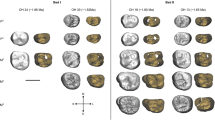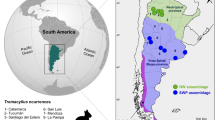Abstract
This paper summarizes the data on morphotype dental patterns in recent lemmings (Lemmini) and their earliest presumed ancestors based on analysis of both the existing literature and zoological collections. The criteria for distinguishing the morphotypes are unified, and four metrics are proposed for assessment: (1) the occlusal surface complexity, (2) the regularity of enamel cutting edges, (3) the asymmetry of the lingual and buccal prisms, and (4) the degree of cement deposition in reentrant angles. A catalogue of basic, reserve, and rare morphotypes has been created for Lemmus sibiricus and Myopus schisticolor. The approach developed here is recommended for further research into the spatial, temporal, and ontogenetic variation in Lemmini, based on their dental characters.






Similar content being viewed by others
REFERENCES
Abramson, N.I., True lemmings Lemmini Simpson, 1945 (Rodentia, Cricetidae), their position in the system and evolution, Extended Abstract, Cand. Sci. (Biol.) Dissertation, Leningrad: Zool. Inst., 1989.
Abramson, N.I., Morphotypic variability of the structure of the masticatory surface of molars in the Palaearctic species of the genus Lemmus (Rodentia, Cricetidae), Zool. Zh., 1986, vol. 65, no. 3, pp. 416–425.
Abramson, N.I., Evolutionary trends in the dentition of true lemmings (Lemmini, Cricetidae, Rodentia): functional-adaptive analysis, J. Zool., 1993, vol. 230, pp. 687–699.
Abramson, N.I. and Lissovsky, A.A., Subfamily Arvicolinae, in Mlekopitayushchie Rossii. Sistematiko-geograficheskii spravochnik (Mammals of Russia: A Taxonomic-Geographic Reference Book), Pavlinov, I.Ya. and Lissovsky, A.A., Eds., Moscow: Tovar. Nauchn. Izd. KMK, 2012, pp. 220–276.
Abramson, N.I. and Nadachowski, A., Revision of fossil lemmings (Lemminae) from Poland with special reference to the occurrence of Synaptomys in Eurasia, Acta Zool. Cracov., 2001, vol. 44, no. 1, pp. 65–77.
Abramson, N.I. and Petrova, T.V., Revision of the composition and distribution of true lemmings (Lemmus Link, 1795) of the North-East of Russia, according to the results of genetic analysis of museum collections, in Teriofauna Rossii i sopredel’nykh territorii (Theriofauna of Russia and Adjacent Countries), Moscow: Tovar. Nauchn. Izd. KMK, 2016, p. 9.
Abramson, N.I., Lebedev, V.S., Tesakov, A.S., and Banikova, A.A., Supraspecies relationships in the subfamily Arvicolinae (Rodentia, Cricetidae): an unexpected result of nuclear gene analysis, Mol. Biol. (Moscow), 2009, vol. 43, no. 5, pp. 834–846.
Bol’shakov, V.N., Vasil’eva, I.A., and Maleeva, A.G., Morfotipicheskaya izmenchivost’ zubov polevok (Morphotypic Variability of Vole Teeth), Moscow: Nauka, 1980.
Borodin, A.V., Opredelitel’ zubov polevok Urala i Zapadnoi Sibiri (pozdnii pleistotsen–sovremennost’) (Identification Guide to the Teeth of Voles of the Urals and Western Siberia (Late Pleistocene–Present Time)), Yekaterinburg: Ural. Otd. Ross. Akad. Nauk, 2009.
Buzan, E.V., Krystufek, B., Hänfling, B., and Hutchinson, W.F., Mitochondrial phylogeny of Arvicolinae using comprehensive taxonomic sampling yields new insights, Biol. J. Linn. Soc., 2008, vol. 94, no. 4, pp. 825–835.
Chaline, J., Brunet-Lecomte, P., Brochet, G., and Martin, F., Les Lemmings Fossiles du Genere Lemmus (Arvicolidae, Rodentia) dans le Pleistocene de France, Geobios, 1989, no. 22, fasc. 5, pp. 613–623.
Chaline, J., Laurin, P., Brunet-Lecomte, P., and Viriot, L., Morphological trends and rates of evolution in arvicolids (Arvicolidae, Rodentia): towards a punctuated equilibria/disequilibria model, Quat. Int., 1993, vol. 19, pp. 27–39.
Cheprakov, M.I., Morphological variability of Palearctic representatives of the genus Lemmus under laboratory conditions, Extended Abstract, Cand. Sci. (Biol.) Dissertation, Yekaterinburg: Institut Ekologii Rastenii i Zhivotnykh, Ural. Otd., Ross. Akad. Nauk, 1993.
Cheprakov, M.I., Variability of the shape of the molar chewing surface in common lemmings (Lemmus), Nauchn. Vestn. Yamalo-Nenets. Avtonom. Okruga, 2010, no. 1 (64), pp. 75–82.
Cheprakov, M.I., The occurrence of cement deposits in the terminal molar synclines in Eurasian members of the tribe Lemmini (Rodentia, Arvicolinae), Zool. Zh., 2016, vol. 95, no. 8, pp. 966–975.
Eskelinen, O., Studies on the Ecology of the Wood Lemming, Myopus Schisticolor, Joensuu: Univ. Joensuu, 2004.
Fejfar, O. and Repenning, Ch.A., The ancestors of lemmings (Lemmini, Arvicolidae, Cricetidae, Rodentia) in the early Pliocene of Wölfersheim near Frankfurt am Main, Germany, Senckenbergia Lethaea, 1998, vol. 77, pp. 161–193.
Fejfar, O., Heinrich, W.D., Kordos, L., and Maul, L.C., Microtoid cricetids and the early history of arvicolids (Mammalia, Rodentia), Palaeontologia Electronica, 2011, vol. 14, pp. 1–38.
Gromov, I.M. and Polyakov, I.Ya., Mlekopitayushchie (Mammmals), in Fauna SSSR (Fauna of the USSR), Leningrad: Nauka, 1977, vol. 3, no. 8.
Guthrie, R.D., Factors regulating the evolution of microtine tooth complexity, Zeitschrift für Säugetierkunde, 1971, vol. 36, pp. 37–54.
Khenzykhenova, F.I., Small mammals of the Baikal region in the Middle Pleistocene–Early Holocene, Extended Abstract, Cand. Sci. (Biol.) Dissertation, Novosibirsk, 2003.
Kochev, V.A., Quantitative assessment of the variability of the chewing surfaces of molars in arctic lemming, in Morfologicheskie osobennosti pozvonochnykh zhivotnykh Ukrainy (Morphological Features of Vertebrate Animals of Ukraine), Kiev: Naukova Dumka, 1983, pp. 59–62.
Königswald, W. and Martin, L.D., Revision of the fossil and recent Lemminae (Rodentia, Mammalia), in Papers in Paleontology Honoring Robert Warren Wilson, Mengel, R.M., Ed., Pittsburgh: Carnegie Museum Natural History Special Publication, 1984, vol. 9, pp. 122–137.
Krukover, A.A. Quaternary microtheriofaunas of the periglacial and off-glacier regions of Western Siberia, Extended Abstract, Cand. Sci. (Geol.-Mineral.) Dissertation, Novosibirsk, 1992.
Larina, N.I. and Lapshov, V.A., To the method of distinguishing age groups in non-root voles, in Fiziologicheskaya i populyatsionnaya ekologiya zhivotnykh. Mezhvuzovskii nauchnyi sbornik (Physiological and Population Ecology of Animals: Interuniversity Scientific Collection), Saratov: Sarat. Univ., 1974, no. 2 (4) pp. 92–97.
Markova, E.A., Assessment of tooth complexity in arvicolines (Rodentia): a morphotype ranking approach, Biol. Bull. (Moscow), 2014, vol. 41, no. 7, pp. 589–600.
Markova, E., Sibiryakov, P., and Ehrich, D., Surviving in the high arctic: dental variation in a casually introduced population of Microtus rossiaemeridionalis (Arvicolinae, Rodentia) on Svalbard, Acta Zoologica, 2016, vol. 97, no. 4, pp. 442–453.
Markova, E.A., Sibiryakov, P.A., Kartavtseva, I.V., Lapin, A.S., Morozkina, A.V., et al., What can an invasive species tell us about evolution? A study of dental variation in disjunctive populations of Microtus rossiaemeridionalis (Arvicolinae, Rodentia), J. Mammal. Evol., 2017. doi 10.1007/s1091401794011
Martin, R.A., Duobinis-Gray, L., and Crockett, C.P., A new species of Early Pleistocene Synaptomys (Mammalia, Rodentia) from Florida and its relevance to southern bog lemming origins, J. Vertebr. Paleontol., 2003, vol. 23, no. 4, pp. 917–936.
Van der Meulen, A.J., Middle Pleistocene smaller mammals from the Monte Pegalia (Orvieto, Italy) with special reference to the phylogeny of Microtus (Arvicolidae, Rodentia), Quaternaria, 1973, vol. 17, pp. 1–144.
Musser, G.G. and Carleton, M.D., Superfamily Muroidea, in Mammal Species of the World: A Taxonomic and Geographic Reference, Wilson, D.E. and Reeder, D.M., Eds., Baltimore: J. Hopkins Univ. Press, 2005, 3rd ed., pp. 894–1531.
Nadachowski, A., Late Quaternary Rodents of Poland with Special Reference to Morphotype Dentition Analysis of Voles, Warszawa: Panstwowe Wydawnictwo Naukowe, 1982.
Ponomarev, D., Puzachenko, A., and Isaychev, K., Morphotypic variability of masticatory surface pattern of molars in the recent and Pleistocene Lemmus and Myopus (Rodentia, Cricetidae) of Europe and Western Siberia, Acta Zoologica, 2015, vol. 96, pp. 14–29.
Rodgers, A.R. and Lewis, M.C., Diet selection in Arctic lemmings (Lemmus sibiricus and Dicrostonyx groenlandicus): demography, home range, and habitat use, Can. J. Zool., 1986, vol. 64, pp. 2717–2727.
Smirnov, N.G., Bol’shakov, V.N., and Borodin, A.V., Pleistotsenovye gryzuny severa Zapadnoi Sibiri (Pleistocene Rodents of the North of Western Siberia), Moscow: Nauka, 1986.
Smirnov, N.G., Golovachev, I.B., Bachura, O.P., Kuznetsova, I.A., and Cheprakov, M.I., Complicated cases of determining the teeth of rodents from deposits of Late Pleistocene and Holocene of tundra regions of North Eurasia, in Materialy po istorii i sovremennomu sostoyaniyu fauny severa Zapadnoi Sibiri (Materials on the History and Present State of the Fauna of the North of Western Siberia), Kosintsev, P.A., Ed., Chelyabinsk: Rifei, 1997, pp. 60–90.
Soininen, E.M., Zinger, L., Gielly, L., and Ims, R.A., Shedding new light on the diet of Norwegian lemmings: DNA metabarcoding of stomach content, Polar Biol., 2013, vol. 36, no. 7, pp. 1069–1076.
Takken Beijersbergen, L.M., The Middle Pleistocene Lemmus (Arvicolidae, Rodentia, Mammalia) in NorthWestern Europe, Courier Forschungsinstiut Senckenberg, 2006, vol. 256, pp. 173–192.
Yannic, G., Burri, R., Malikov, V.G., and Vogel, P., Systematics of snow voles (Chionomys, Arvicolinae) revisited, Mol. Phylogenet. Evol., 2011, vol. 62, no. 3, pp. 806–815.
ACKNOWLEDGMENTS
We are grateful to the curators of the museum of the IPAE UrB RAS (Yekaterinburg) and all our colleagues who participated in capturing and cameral processing of the collections examined.
This study was supported by the Russian Foundation for Basic Research, project no. 16-04-01486.
Author information
Authors and Affiliations
Corresponding author
Ethics declarations
Conflict of interests. The authors declare that they have no conflict of interest.
Statement on the welfare of animals. This article does not contain any studies involving animals performed by any of the authors.
Additional information
Translated by I. Matiulko
Rights and permissions
About this article
Cite this article
Markova, E.A., Bobretsov, A.V., Starikov, V.P. et al. Unification of Criteria for Distinguishing Morphotypes of Cheek Teeth in Lemmings (Lemmini, Arvicolinae, Rodentia). Biol Bull Russ Acad Sci 45, 1083–1095 (2018). https://doi.org/10.1134/S106235901809011X
Received:
Published:
Issue Date:
DOI: https://doi.org/10.1134/S106235901809011X




